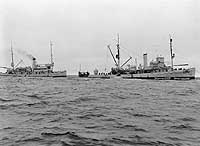
At 8:40 AM on 23 May 1939, USS Squalus was just beginning a test dive in the Atlantic, not far from Portsmouth, New Hampshire. All indications were that everything was ready for a safe dive. However, just after she submerged, the engine rooms began to flood -- somehow the main induction valve, a large opening that brought air to the engines while on the surface, had opened. Quickly, the submarine's after compartments filled with water, drowning 26 men there, and Squalus settled to the bottom, 243 feet deep. In the forward compartments, sealed by watertight doors, 33 men remained alive. Their Commanding Officer, Lieutenant Oliver F. Naquin, began survival planning. Since the water depth and temperature made ascent with the self-contained "Momsen Lung" very dangerous, he elected to wait for rescue from above.
Within a few hours, other ships were searching for the missing Squalus, unfortunately in the wrong place. However, in the early afternoon a distant signal rocket was seen from a sister submarine, USS Sculpin (SS-191). Communication via the sunken sub's rescue bouy was soon established, and as soon broken when the bouy's connecting line snapped. The tug Penacook (YT-6) spent the afternoon and evening dragging a grapnel around the sinking site, finally hooking what all hands hoped was Squalus. Meanwhile, a team of divers from Washington, DC, their leader, Lieutenant Commander Charles B. Momsen, and the submarine rescue ship Falcon (ASR-2) were hurrying northward toward Portsmouth. Falcon carried more divers and a McCann Rescue Chamber, a large diving bell specially designed for just such an emergency.
Falcon moored over the Penacook's contact on the morning of 24 May. Divers soon confirmed that the contact was indeed the Squalus. During the afternoon and early evening, the rescue chamber made three relatively smooth round trips to the sunken submarine, bringing up 25 men. Only one more trip would finish the rescue of all those known to be alive. Shortly before 8PM, crewed by Chief Torpedoman's Mate John Mihalowski and Chief Metalsmith James H. McDonald, the rescue chamber picked up the last eight Squalus survivors, including Lieutenant Naquin, and began its ascent. While still 160 feet deep, its guiding cable jammed and the chamber had to return to the Squalus.
Over the next four hours, as problem followed problem, and divers labored heroically to effect repairs, the chamber was in imminent danger of disaster, risking the lives of its ten occupants. However, with careful handling it surfaced safely shortly after midnight on 25 May. During that day, divers and the rescue chamber crew made more difficult trips down to the Squalus, determining that no more crewmen remained alive on board her. The historic rescue mission, the first such undertaking in World history, and one conducted at a time in which the technologies of underwater object location, communications and deep-water diving were in their infancies, was a success.
This page features all the views we have relating to the rescue of survivors after USS Squalus sank on 23 May 1939.
For other photographs concerning the loss of USS Squalus
and the rescue of her survivors, see:
For additional views relating to USS Squalus, see:
| If you want higher resolution reproductions than the digital images presented here, see: "How to Obtain Photographic Reproductions." |
Click on the small photograph to prompt a larger view of the same image.
For other photographs concerning the loss of USS Squalus
and the rescue of her survivors, see:
For additional views relating to USS Squalus, see:
| If you want higher resolution reproductions than the digital images presented here, see: "How to Obtain Photographic Reproductions." |
19 June 2000